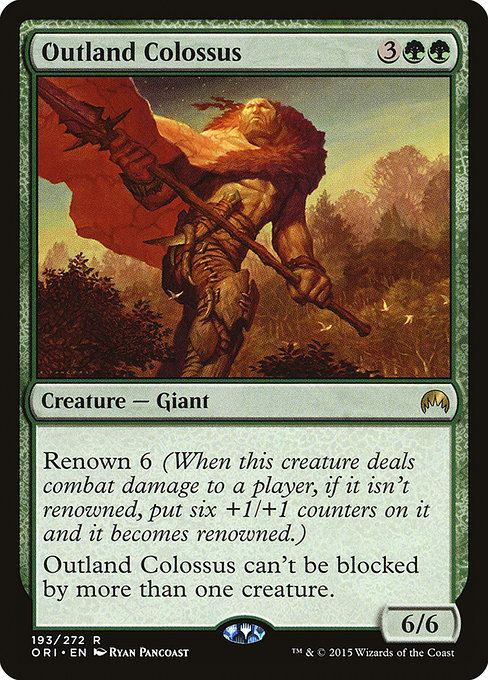
Image courtesy of Scryfall.com
Rarity vs. Mana Cost in a Green Giant
In the world of Magic: The Gathering, the dance between mana cost and board presence is a constant rhythm. Outland Colossus embodies a curious harmony: a five-mana investment that yields a colossal presence and a late-game twist that only reveals itself if you lean into the green ecosystem’s long-game mindset 🧙♂️. This rare creature from Magic Origins asks you to think beyond the numbers on the card and consider how rarity signals a design intent—one that rewards ramp, patience, and a willingness to weather a few early turns for a dramatic late bloom 🔥💎.
Card data snapshot
- Mana cost: {3}{G}{G} (CMC 5)
- Type: Creature — Giant
- Power/Toughness: 6/6
- Rarity: Rare
- Set: Magic Origins (ORI), released 2015
- Colors: Green | Color identity: G
- Keywords: Renown (Renown 6)
- Abilities:
“Renown 6 (When this creature deals combat damage to a player, if it isn't renowned, put six +1/+1 counters on it and it becomes renowned.) This creature can't be blocked by more than one creature.”
From a gameplay standpoint, those five mana buy you a sizable floor: a 6/6 body that can threaten the air-gap between opponents and your open mana, and a built-in line of defense—one of the few green giants that isn’t easily contained by a swarm of small blockers. The clause “cannot be blocked by more than one creature” nudges you toward attack sequences that force single-blockers or late-game crunch, turning your green ramp into a late-game freight train 🚂⚔️.
Rarity as a design signal
Rarity in MTG is more than a decorative badge; it often encodes a card’s expected power curve, availability in booster packs, and long-term value at the table. Outland Colossus sits in the rare tier of Magic Origins, a set that was intentionally accessible for new players while still packing meaningful rares and mythics for veterans. Its 5-mana price tag paired with a 6/6 body and a robust, evergreen mechanic signals that rarity isn’t just about flashiness; it’s about durability. The card’s continued viability in casual and Commander formats reflects a design philosophy: a big, memorable body paired with a strategic, growth-oriented mechanic can outlast a single moment of raw power.
Interestingly, the market data attached to this card—usd around 0.21 and usd foil around 0.52—speaks to a broader story: rarity does not auto-boost price in today’s market if the card’s utility is narrow. Outland Colossus remains a charming collectible for Old-World green lovers and casual players who dink around with Renown themes, rather than a go-to staple in modern competitive decks. Still, the collectible value—especially in foil form—reflects the tactile desire to own a rare from a familiar Core/Origins era, pairing nostalgia with a surprisingly relevant mechanic.
Strategic takeaways for players
- Plan your ramp: Outland Colossus rewards investment in green mana acceleration. Cards that smooth the path to turn five or six—think early forest acceleration, mana dorks in older formats, or even pump spells that help it connect—help the Renown trigger land with maximum impact.
- Play to the single-blocker edge: Its text explicitly prefers one-on-one combat. If your board state invites a swarm, you’ll want to protect the Colossus with combat tricks or removal to ensure it deals damage to a player (the trigger for those six +1/+1 counters).
- Renown timing matters: The first combat damage that connects to a player will either pump the Colossus into a 12/12-or-better threat or set it up for a surprising late-game swing. Until then, it’s a big, resilient inflector waiting for the right moment.
- Synergy in green: This is the flavor of green’s ramp-and-grow archetype—invest, endure, then explode. It pairs well with finisher-minded greens and combat-reducing protections that ensure the Colossus can land its fabled hit.
In broader terms, this card demonstrates how rarity and mana cost can diverge in interesting ways. A five-mana investment yields not just a large creature, but a potential game-ending turn if you sequence your plan correctly. It’s a reminder that MTG’s power curve isn’t a straight line; it’s a spiral that can rise dramatically with the right conditions and a bit of luck on the battlefield 🧙♂️🎲.
Art, flavor, and the design story
Ryan Pancoast’s illustration for Outland Colossus captures the awe-inspiring scale and the primal moment of a green giant pressing forward into the fray. The black frame and clean lines reflect Magic Origins’ return-to-roots aesthetic, while the creature’s stance and the surrounding landscape evoke ancient, forest-hung heft. The art doesn’t merely decorate a card; it invites you to imagine a battlefield where massive beings stride into the thick of combat, their renown echoing as the counters accumulate and the legend grows 🖌️🎨.
And if you’re chasing that same sense of discovery—whether you’re revisiting the Origins era or exploring how green mechanics age—this card serves as a neat case study in how a rare creature can stay relevant across formats and over many years. The flavor of Renown, the inevitability of a late-blooming giant, and the tactile thrill of a foil version all contribute to Outland Colossus’s enduring charm.
Curious about more on the vitality of ancient and modern mechanics? Check out these perspectives from our network to see how rare cards, color identity, and iconic setups shape the way we remember and play MTG today 🔥💎⚔️.
Neon Gaming Mouse Pad Rectangle 1-16 Inch Thick Rubber Base